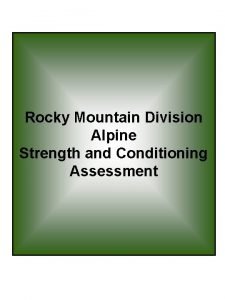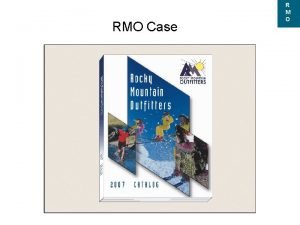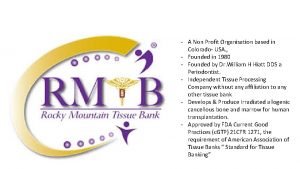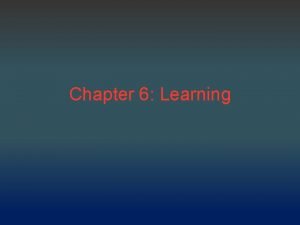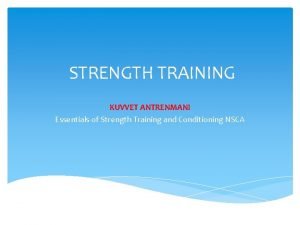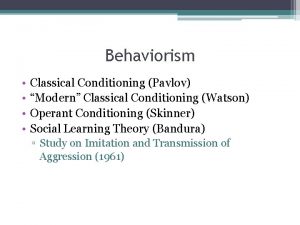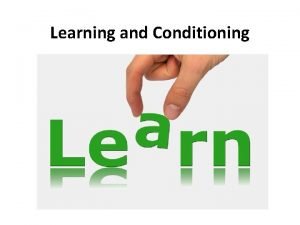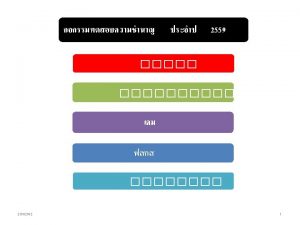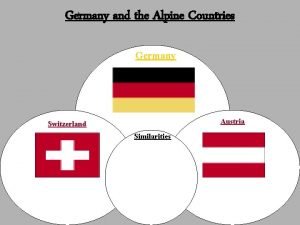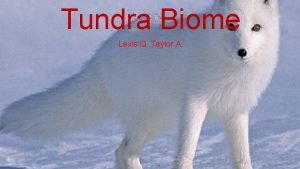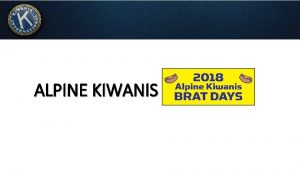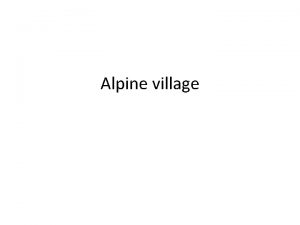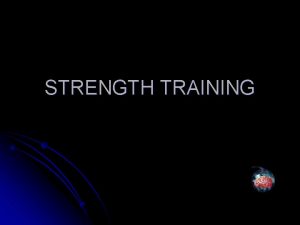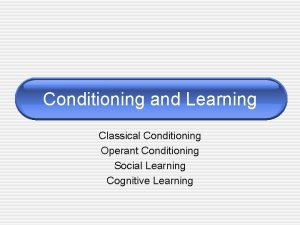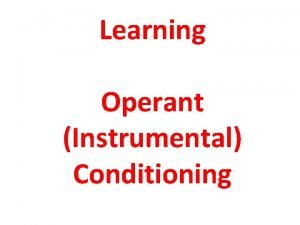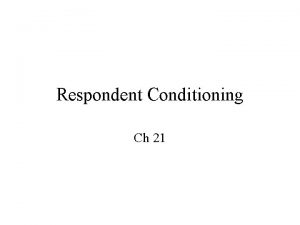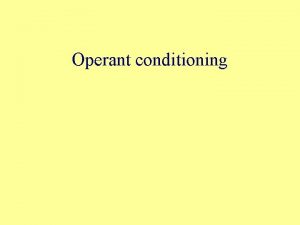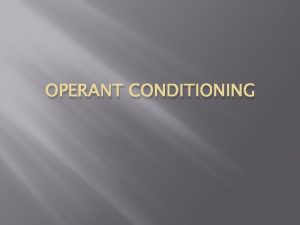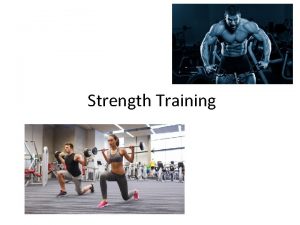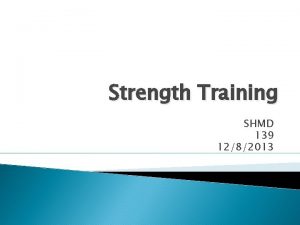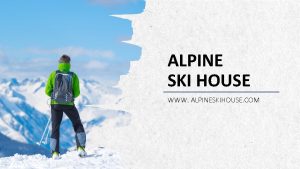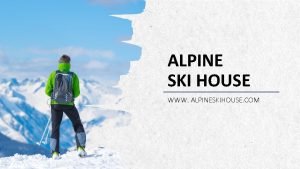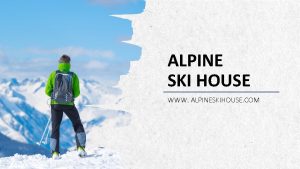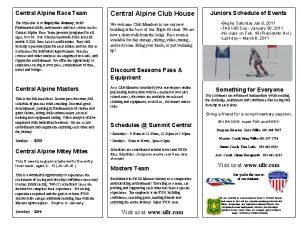Rocky Mountain Division Alpine Strength and Conditioning Assessment

































- Slides: 33

Rocky Mountain Division Alpine Strength and Conditioning Assessment

Rocky Mountain Division Alpine Strength and Conditioning Assessment Table of Contents Page Number 1. 2. 3. 4. 5. Introduction/Overview Assessment Overview/Energy Systems Timeline Protocols a. Five X Forward Jumps b. High Box c. Parallel Back Squat d. Competition Clean e. 1. 5 Mile Run f. Body Composition/Skin Fold g. Flexibility/Sit and Reach h. Four Square Agility i. Core Function/7 Stage Sit-up j. Shuttle Run (option VO 2 Max) k. Vertical Jump Score Sheets a. Parallel Back Squat Technique b. Competition Clean Score Technique c. Strength Assessment Score Sheet d. 7 Level Skin Fold Score sheet e. Individual Score Sheet f. Performance Grid – Men g. Performance Grid – Women h. 7 Level Sit up Test Scores for Men and Women i. Sit and Reach Scores for Men j. Sit and Reach Scores for Women 3 4 5 6 7 8 9 12 13 19 20 21 23 24 25 26 27 28 29 30 31 32 32 33 2 This is a product of Quantum Sports and is not to be used in any form without expressed permission of the USSA and Quantum Sports

Rocky Mountain Division Alpine Strength and Conditioning Assessment Introduction The Alpine Competition Committee of the Rocky Mountain Division is committed to the sport specific fitness of it’s athletes. The strength and conditioning assessment is a tool, combined with coach and athlete education, to improve our conditioning as a basis for meeting our on-snow goal of excellence. Testing will be available for Gold Card nominees and Grass Root athletes. Gold Card nominees recovering from injury may be eligible for alternate tests. Contact Darlene Nolting for details. Re-testing is available for Gold Card nominees at the Grass Roots test. The assessment will evolve according to requirements of our sport and available resources. This assessment is designed for athletes that are members of the Rocky Mountain Division in active conditioning programs over the age of 15. Overview The goals of the Assessment are: • To establish fitness (conditioning) norms that reflect the physiological and psychological demands of the alpine ski competition. • To serve as a tool for assessment and evaluation, or test of fitness as required by Alpine Ski Racing. • To give direction to long term conditioning programs. The assessment tool should interact with conditioning. • To create an environment conducive to athletic achievement. • To assess energy systems and athletic skills consistent with the training and competitive demands of Alpine Ski Racing. • To directly assess strength, speed-strength (power), muscular endurance, VO 2 Max, agility, flexibility, and body composition. • To chart/correlate other physical information affecting athletic performance. Assessment: To determine correlation of a specific fitness component to current training objectives. Assessments may be used at any point in training (preparation) or competition. Evaluation: To determine if the athlete is maintaining or improving in a relationship to a predetermined model. The results of the evaluation should drive the priorities of subsequent training cycle. The following assessments are reflective of evaluative tools necessary to direct an effective training program. We understand that there are other assessments and evaluations. We encourage programs to use other assessments. Test: To use results to determine eligibility for benefits for the Colorado All-Star Team. Athletes must pass the All-Start conditioning Assessment. If an athlete doesn’t pass the All-Start conditioning assessment they may retake the test at the Grass Roots conditioning assessment. This document is a compilation of standard physical assessments designed to evaluate specific fitness categories. The RMD Alpine Assessment was prepared by: John Leffler NSCA-CPT Darlene Nolting, RMD Competition and Development Manager 3 This is a product of Quantum Sports and is not to be used in any form without expressed permission of the USSA and Quantum Sports

Rocky Mountain Division Alpine Strength and Conditioning Assessment Secondary and Primary Tests Body Composition/ROM/Agility/ Core Function Power and Speed Anaerobic Capacity Strength/Strength-Speed Aerobic Capacity/VO 2 Max Energy Systems Non-Oxidative Semi/Non-oxidative Non-Oxidative Exercise 7 point Skin Fold/Sit and Reach/Four Square Agility 7 Stage Sit up Five X/Double Leg High Box 60 seconds Parallel Back Squat/Competition Clean 1. 5 Mile Run Slalom 45”-50” Giant Slalom 70”-90” Super Giant 80”-120” Downhill 90”-150” 4 This is a product of Quantum Sports and is not to be used in any form without expressed permission of the USSA and Quantum Sports

Rocky Mountain Division Alpine Strength and Conditioning Assessment RMD Conditioning Assessment Protocol/Timeline 5 This is a product of Quantum Sports and is not to be used in any form without expressed permission of the USSA and Quantum Sports

Rocky Mountain Division Alpine Strength and Conditioning Assessment POWER – Five X: Five consecutive forward jumps. Assessment v Speed and Power v Maintaining momentum v Agility, Balance, Coordination, Athleticism Protocol 1. Mark the start line with tape two feet wide. 2. Place tape measure perpendicular to start line continuing for 55 feet. 3. Place markers perpendicular to tape every five feet beginning at 25 feet. 4. The athlete starts with both toes behind start-line, and from a standing position executes five continuous forward jumps. 5. Feet must contact/leave surface at the same time, no skipping/hopping. 6. The tester counts jumps out loud on take-off of each jump, i. e. “one, two, etc The tester uses pole to mark farthest back contact point on fifth jump (back of heel/hand etc. ). Pole is placed perpendicular to tape to establish score. 7. Surface should be short dry grass/rubberized track/sport floor/gym floor 8. Three trials – score the best result. Performance Keys â Full range of motion â Both arms swing from behind hips and reach forward to full extension â Deep hip/knee flexion to full knee and hip extension â Contact is at heel, roll to ball of foot in continuous forward motion. Do not stop and go. â Powerful exhalation on extension â Keep eyes forward, project vision down the track â Keep knees over the feet 6 This is a product of Quantum Sports and is not to be used in any form without expressed permission of the USSA and Quantum Sports

Rocky Mountain Division Alpine Strength and Conditioning Assessment ANAEROBIC Capacity – High Box: Continuous jumping on high box. Assessment v Power and speed in an environment of muscular endurance v Lactate threshold v Agility, Balance, Core Protocol 1. This is a 60 -second timed test. Counting the number of times (touches) the athlete successfully jumps from top of box (start position) and returns to top of box with both feet (simultaneously). 2. The athlete begins standing on the top of the box. The box is positioned so the long dimension is to the front/back of the athlete and is stabilized on both ends. 3. The Timer of the test gives the command; “READY, GO” and starts the watch on “GO”. 4. The athlete moves laterally down to the floor on one side, returning to the top of the box with a jumping motion. The athlete repeats the motion on the opposite side and continues cycle until the Timer says, “STOP” at 60 seconds. Feet must simultaneously contact floor surface and contact (no skipping or stepping) box surface to score points. 5. Athlete scores each time they return to the top of the box and is counted in 15 second progressive increments, i. e. 19/37/55/72 jumps at 15/30/45/60 second increments. If possible monitor/chart heart rate (HR) at above increments. 6. Ground surface should be short dry grass/rubberized track/sport floor/gym floor 7. Box dimensions a. 8. 15 years and older – 40 cm wide X 50 cm long X 40 cm high One Trial – 60 seconds Performance Keys â Maintain upright mid and upper body posture. â Powerful exhalation on take-off from ground surface. â Hands should work in coordination with take off. â The athlete should focus on plyometric action to maximize force production. â The athlete should concentrate on establishing balance on the box and speed on 7 ground contact. This is a product of Quantum Sports and is not to be used in any form without expressed permission of the USSA and Quantum Sports

Rocky Mountain Division Alpine Strength and Conditioning Assessment STRENGTH – Parallel Back Squatting is the foundation for all lower body/total body conditioning. Assessment v Critical technical components that are required for safe, effective squatting. v Demonstrate knowledge control of critical depths. v Demonstrate knowledge of tempo/cadence critical to performing explosive (isotonic), isometric and eccentric styles of loading. v Functional flexibility, core body stability. v Strength within the above criteria. Protocol The strength protocol will have two phases. Phase I will concentrate on technique and Phase II will be an evaluation of strength under the conditions of a technical foundation. Phase I Protocol 1. Each athlete will perform five lifts according to the chart below. 2. Ten point analysis. Seven critical points. See Technique Assessment Sheet for Ten point analysis. First seven points on Technique Assessment Sheet are the critical points. 3. Athletes must pass the critical elements to advance to the strength phase of test. 4. All loads are subject to judgment of the tester. 5. Loads are not to be invasive to ensure assessment can be completed. This is a product of Quantum Sports and is not to be used in any form without expressed permission of the USSA and Quantum Sports 8

Rocky Mountain Division Alpine Strength and Conditioning Assessment STRENGTH – Parallel Back Squat Phase I Protocol, continued 6. Load Chart 7. Scorer and or Spotter responsibilities 8. a. Two Scorers evaluate the Technique Phase of Assessment. b. Scorer creates a cross pattern with tape on the floor, 24” wide, 12” depth. c. Scorer evaluates technique. Any (-) score results in a failed attempt. d. Assessment may be done inside or outside power rack. e. Spotter should maintain close proximity to athlete. The spotter should be aggressive in assisting the athlete. Spotter should practice with athlete during warm-up phase. f. Athletes who have previously passed the technique evaluation should proceed to the load test. Testers will review essential technique requirements during the warm-up phase. Training Depths Equivalent terms 1. 45 degrees 2. 90 3. Parallel 100 degrees(+/-) thigh/femur parallel with floor 4. 135 (+/-) Power ¼ Squat Athletic Stance ½ Squat Full Squat Competition Depth 9 This is a product of Quantum Sports and is not to be used in any form without expressed permission of the USSA and Quantum Sports

Rocky Mountain Division Alpine Strength and Conditioning Assessment STRENGTH – Parallel Back Squat and Competition Clean Phase II Athlete must complete strength assessment without a single negative score in critical areas (1 -7). A current training log is required to create strength assessment goals. The athlete must submit signed Strength Assessment Goal sheet. Goal Sheet is available in the score sheet section of the book. The Competition Clean assessment will be executed with single lifts to goal and failure after warm-up period. Assessment v Strength under conditions of technical competency. To establish a theoretical maximum, TM, for Parallel Back Squat and 1 RM Max for Clean. v To validate current training status. The evaluation is not designed to establish personal records. v Strength relative to age and body weight. v Absolute strength. Power. v Functional flexibility. Core strength. Phase II Protocol 1. Establish warm-up weights, trial weights and number of repetitions and record on Individual Strength Assessment Sheet. Athletes who do not provide signed ISAS will not be allowed to lift weight above their body weight. 2. One scorer and a spotter evaluate and support the Strength Phase of Assessment. 3. Strength Assessment should be done inside a power rack with support/safety pins set at depth slightly below athlete’s parallel squat range. 4. Spotter squats with athlete, maintaining depth sufficient to support athlete in all phases. Spotter should pay special attention to supporting the upper body over the center of lifter if necessary. Spotter should maintain light contact with lifter in order to respond effectively to any failures. 5. Spotter/scorer validates the lift. 6. Belt may be used above 85% of Maximum. 7. Warm up weight: Approximately 50% of trial # 1 weight. 10 This is a product of Quantum Sports and is not to be used in any form without expressed permission of the USSA and Quantum Sports

Rocky Mountain Division Alpine Strength and Conditioning Assessment STRENGTH – Parallel Back Squat and Competition Clean Phase II Protocol, continued 8. Repetitions by age: a. 15 to 16 yrs – 4 to 6 b. 17 to 18 yrs – 2 to 4 c. Over 19 yrs – 2 to 3 9. Execute 3 to 4 repetitions at warm-up weight. 50% of predicted Max. 10. Begin Trial one – after the first or second repetition, if weight appears light or heavy, restart with adjusted weight. 11. If athlete fails or falls outside of technical parameters, the assessment is compete. If athlete completes the set, athlete and tester determine if a trial with a heavier weight is appropriate. 2 -5 minute intervals between trials determined by difficulty of the previous trial. 12. Spotter maintains contact with lifter at every phases. Spotter must maintain proper form to be able to properly assist lifter. Spotter is considered a tester and must validate the lift. 13. Use only properly completed lifts for scoring. 14. Use the weight lifted and theoretical maximum weight chart to determine TM. 15. Enter Theoretical Maximum on result sheet. 16. Competition clean follows the same general plan. Each trial is composed of a single repetition with a 3 -5 minute rest interval between trials. 11 This is a product of Quantum Sports and is not to be used in any form without expressed permission of the USSA and Quantum Sports

Rocky Mountain Division Alpine Strength and Conditioning Assessment AEROBIC CAPACITY – 1. 5 Mile Run Assessment v Muscular and cardiovascular endurance (capacity). v Establish a predicted VO 2 Max level. Protocol 1. Surface should be a Rubberized track – 400 meters/440 yards. 2. Tester will keep master watch/time for each group. The assistant (recorder) will chart final time for each athlete on master sheet. 3. Each athlete will have a partner who will record lap time/HR at the end of each lap. 4. A heart rate monitor (HR) is required. The partner will keep track of HR/lap time at end of each lap. 5. Predicted VO 2 Max will be included on final results. a. 6. A correction factor, when appropriate will be calculated on final results. a. 7. VO 2 Max (ml/kg/min) = 3. 5 + 483/Time (minutes to nearest 100 th of a minute) To compensate for decreased aerobic performance as altitude increases the following formula should be used. For every full 1, 000 ft over 5, 000 ft subtract two (2) percent from total time. One Trial Performance Keys â Maintain proper running form: erect posture, elbows at 90 degrees, arms relaxed coordinated with foot falls, foot strike/take-off-heel to toe, maintain smooth rolling motion. â Maintain diaphragmatic breathing coordinated with foot falls â Establish lap times. Pace time +/- â First lap: – 3/-5 seconds â Second lap: – 2/-3 seconds â Third lap: on pace â Fourth lap: on pace â Fifth lap: +2/+3 seconds â Sixth lap; +3/+5 This is a product of Quantum Sports and is not to be used in any form without expressed permission of the USSA and Quantum Sports 12

Rocky Mountain Division Alpine Strength and Conditioning Assessment BODY COMPOSITION – Seven Site Skinfold Testing Protocol Assessment v Body Composition determined from skinfold measurements correlates well with body composition determined from hydrostatic weighing. The principle behind this technique is that the amount of subcutaneous fat, just under the skin is proportional to the total amount of body fat. Protocol 1. 2. Locate the skinfold site. a. To increase accuracy, the site should be marked with an erasable marker or felt tip pen. This helps to ensure that the calipers are placed in the correct position each time the skinfold is measured. b. Measurements should be taken on the right side of the body. Pinching the skinfold away from underlying tissues a. Place fingers perpendicular to the skinfold approximately 1 cm from the site to be measured. b. Gently but firmly pinch the skinfold between the thumb and first two fingers and lift away from the underlying tissues. c. Place jaws of the caliper at the measurement site perpendicular to skinfold. The jaws of the caliper should only be halfway between the bottom and top of the fold. Maintain pinch while taking measurement. d. Read the measurement on the caliper 1 to 2 seconds after the jaws come into contact with the skin. e. Wait at least 15 seconds before taking a subsequent measurement. This allows the fold to return to normal, take on measurement at each site, then repeat the measurements. If the second measurement varies by more than 1 or 2 mm, repeat the measurement a third time. 3. Measuring with calipers. 4. Measurements should be taken prior to exercise because exercise can lead to inaccurate results due to fluid volume shifts. 5. Measurements should be taken in a discrete location with the proper gender taking the measurements: 1. Females taking female measurements – females should wear sports bras 2. Males taking male measurements This is a product of Quantum Sports and is not to be used in any form without expressed permission of the USSA and Quantum Sports 13

Rocky Mountain Division Alpine Strength and Conditioning Assessment BODY COMPOSITION – Seven Site Skinfold Testing Protocol 4. Choosing the proper equation. a. By inserting the athletes skinfold measurement and age in years into these equations an estimate of the athletes body density is gained. Body Density is then converted to % Body Fat by using the Siri Equation. b. Step one determining Body Density (Db) c. Women 7 Sites d. e. 1. Db = 1. 097 -0. 00046971(A 4) + 0. 00000056(A 4)2 – 0. 00012828(A 2) 2. A 4 = sum of triceps, abdominal, suprailiac, thigh, chest, subscapular, and midaxillary skinfolds 3. A 2 = age in years Men 7 Sites 1. Db = 1. 112 – 0. 00043499(A 4) + 0. 00000055(A 4)2 – 0. 00028826(A 2) 2. A 4 = sum of triceps, abdominal, suprailiac, thigh, chest, subscapular, and midaxillary skinfolds 3. A 2 = age in years Step two converting body density(Db) into body fat percentage(%BF) 1. Women - %BF = (501/ Db) -457 2. Men - %BF = (495/ Db) – 450 14 This is a product of Quantum Sports and is not to be used in any form without expressed permission of the USSA and Quantum Sports

Rocky Mountain Division Alpine Strength and Conditioning Assessment BODY COMPOSITION – Seven Site Skinfold Testing Protocol SKINFOLD SITES Triceps Chest • Vertical fold • Posterior midline of the upper arm • Halfway between the acromion (shoulder) and olecranon processes (elbow) • Arm held freely to the side of the body • Diagonal fold • Men: one-half the distance between the anterior axillary line (crease of the underarm) and the nipple • Women: one-third of the distance between the anterior axillary line and the nipple 15 This is a product of Quantum Sports and is not to be used in any form without expressed permission of the USSA and Quantum Sports

Rocky Mountain Division Alpine Strength and Conditioning Assessment BODY COMPOSITION – Seven Site Skinfold Testing Protocol SKINFOLD SITES Midaxillary Subscapular • Vertical or Horizontal fold • Midaxillary line at the level of the xiphoid process of the sternum • Diagonal fold • 1 to 2 cm below the inferior angle of the scapula 16 This is a product of Quantum Sports and is not to be used in any form without expressed permission of the USSA and Quantum Sports

Rocky Mountain Division Alpine Strength and Conditioning Assessment BODY COMPOSITION – Seven Site Skinfold Testing Protocol SKINFOLD SITES Supraillac Abdominal • Diagonal fold • Anterior axillary line (modern technique) • immediately superior to the iliac crest • in line with the natural angle of the iliac crest taken • Mid-axillary line (traditional technique) • Superior to the iliac crest • Vertical (modern technique) • 2 cm or 1" to the right side of the umbilicus • Horizontal fold (traditional) • 2 cm to the right side of the umbilicus 17 This is a product of Quantum Sports and is not to be used in any form without expressed permission of the USSA and Quantum Sports

Rocky Mountain Division Alpine Strength and Conditioning Assessment BODY COMPOSITION – Seven Site Skinfold Testing Protocol SKINFOLD SITES Thigh Other Sites Biceps • Vertical fold • Anterior aspect of the arm over the belly of the biceps muscle • 1 cm above the level used to mark the triceps site • Vertical fold • Anterior midline of the thigh • Midway between the proximal border of the patella (upper knee) and the inguinal crease (hip) Calf • Vertical fold • maximum circumference of calf on the midline of medial border Skinfold site illustration from Trainer Clip Art CD-ROM www. exrx. net/Testing/Body/Comp. Sites. html This is a product of Quantum Sports and is not to be used in any form without expressed permission of the USSA and Quantum Sports 18

Rocky Mountain Division Alpine Strength and Conditioning Assessment FLEXIBILITY – Sit and Reach Assessment v Measurement of the forward reach of the athlete is a very general flexibility measure which has been found to be related to the general flexibility of the athlete. v Measurement of anterior flexion of the torso at the hips, by the distance an athlete can reach beyond their toes. Protocol 1. A “sportech” sit-and-reach box or equivalent. 2. Allow the athlete one practice – not at full stretch. In order to maintain the accuracy and reliability of the results of this test it is essential that it be performed “cold” without any preliminary warm-up. 3. Check the integrity of the sit-and reach box or equivalent prior to each test day. Note: Zero is set at the toes, any point reached prior to the toes is measured as a negative score, and any point reached past the toes is measured as a positive score. 4. Rest sit-and-reach box against a wall. 5. Seat subject, barefooted, with soles of both feet flat against the front of the box. 6. Explain that the subject must: a. Keep legs straight and back of knees flat on the floor. b. Place one hand above the other so the fingertips of both hands remain level. c. Reach slowly forward as far as possible without jerking and hold this position for a minimum of 3 seconds until told to relax. 7. As the subject performs each trial the recorder should place their hands above the subject’s knees to ensure that the legs remain straight (do not hold the knees down), and count three seconds after which the measurement can be noted. 8. This process is repeated three times. Trials should be a gradual progression designed to elicit the best performance with the third trial. 9. Measure and record the distance reached on the best trial to the nearest 0. 5 cm. 19 This is a product of Quantum Sports and is not to be used in any form without expressed permission of the USSA and Quantum Sports

Rocky Mountain Division Alpine Strength and Conditioning Assessment AGILITY – Four Square Agility Test Assessment v Double leg jumps/Single leg hops in a multi plane/multi directional agility v Foot speed/foot precision. v Balance v Reaction Time Protocol 1. Create a 4 square grid with 1” to 1 ½” wide athletic tape, three foot x three foot which creates four, 18” x 18” squares. Orient grid on clock face, 12 -6, 3 -9 axis. The quadrants are numbered 1 – 2 – 3 – 4. Quadrant 1 is 12 o’clock to 9, Quadrant 2 is 12 o’clock to 3, Quadrant 3 is 6 o’clock to 9 and Quadrant 4 is 3 o’clock to 6. 2. A Trial consists of 2, 10 second bouts. a. Bout 1 sequence: 1 – 2 – 3 – 4. b. Bout 2 sequence: 4 – 3 – 2 – 1. 3. Scoring – 6 trials, two (2) jumping with both feet, four (4) hopping, 2 on each leg. Best jumping trial + best left leg trial+ best right leg hopping trail = final score. Circle deficient single leg if > 10%. 4. Trial is scored by total touches minus faults x two bouts. 5. Touch is feet/foot contact in appropriate quadrant. 6. Fault occurs if feet/foot touches the tape, outside the quadrant or is not in the proper quadrant. 7. Athlete begins standing in quadrant 1 or 4 depending on the bout. Tester commands “READY – GO”. Athlete jumps or hops repeating the sequence until tester commands “STOP” 8. Rest Intervals. This a “Go-When-Ready” protocol. Maximum time between bouts: 30 seconds. Maximum time between trials: 2 minutes. 9. Assistant #1 counts touches and records results 10. Assistant #2 counts faults. 11. Quadrant detail 20 This is a product of Quantum Sports and is not to be used in any form without expressed permission of the USSA and Quantum Sports

Rocky Mountain Division Alpine Strength and Conditioning Assessment CORE FUNCTION – Seven Stage Sit-up Assessment v Measurement of functional strength of the abdominal muscles. v This is a test consisting of 7 levels, performed through a series of functionally distinct sit-ups which become progressively harder in relation to the athlete’s abdominal function. Protocol 1. Clear floor area and mat. 2. 5 kg weight disc, 5 kg weight disc. 3. Set square. 4. Start and finish position: The subject lies supine on the floor or mat, with their feet and back flat on the floor and knees raised so that their tibia and femur are at 90 degrees (use a set square to establish that the tibia and femur angle is 90 degrees). 5. For all levels the subject is asked to tilt their pelvis back to flatten the lower back onto the floor. They are then asked to tilt their head forwards so that their chin is tucked in towards their chest. They then smoothly flex the trunk in a controlled manner until the requirements of the level being executed are completed. After the execution of each level the subject returns to the starting position. 6. The subject always completes each level in sequence until they fail. 7. The last successful level is recorded as that achieved by the subject. 8. An attempt is considered unsuccessful if the subject displays poor technique during a sit-up: a. Lifting either heel off the floor. b. Jerking forward quickly in order to create momentum to lift the body off the floor. c. Throwing the arms or head forward, moving arms from the nominated position. d. Lifting hips from the floor. e. Failing to maintain a 90 degree knee angle. f. Being unable to complete the sit-up. This is a product of Quantum Sports and is not to be used in any form without expressed permission of the USSA and Quantum Sports 21

Rocky Mountain Division Alpine Strength and Conditioning Assessment CORE FUNCTION – Seven Stage Sit-up, continued Levels 1 -7 of core function test: Level 1 Subject to place both arms relaxed by their sides, and perform a pelvic tilt with their back flattened on the floor. Level 2 Subject to perform a sit-up with both arms relaxed by their sides, bringing fingers to touch the heels, while the feet are held by the assessor. Level 3 As above but with the feet not held; Feet must maintain full contact with the floor throughout the movement. Level 4 Arms flexed across abdomen, hands gripping opposite elbows, flex the trunk to perform a sit-up until the back of the forearms touch the thighs: Feet must maintain full contact with the floor and forearms must maintain contact with the abdomen throughout the movement. Level 5 Arms flexed behind the head, hands gripping opposite shoulders, flex the trunk to perform a sit-up until the chest touches the thighs. Feet must maintain full contact with the floor throughout the movement. Level 6 Arms flexed behind the head with hands gripping opposite sides of a 2. 5 kg weight disc behind the shoulders, flex the trunk to perform a situp until the chest touches the thighs. Feet must maintain full contact with the floor throughout the movement. Level 7 Arms flexed behind the head with hands gripping opposite sides of a 5 kg weight disc behind the shoulders, flex the trunk to perform a sit-up until the chest touches the thighs. Feet must maintain full contact with the floor throughout the movement. 9. Record the last successful level that is achieved by the subject. 22 This is a product of Quantum Sports and is not to be used in any form without expressed permission of the USSA and Quantum Sports

Rocky Mountain Division Alpine Strength and Conditioning Assessment AEROBIC CAPACITY – Shuttle Run Assessment v Muscular and cardiovascular endurance in an environment of agility, ABC. Protocol Surface: Gym floor/rubberized tack- 20 meter (65’ 6”), length 1 meter(30”-36”) per athlete required. Track with lanes or gym floor with cones demarcating start/end and lanes required. Apparatus: Mobile CD Player. v Acquaint athletes with beeper cadence system, and proper technique for stepping over end line, turn and return to opposite end line. Athletes must stay in lane. Athletes should not create a circular pattern. Use track two on CD. v Begin test with track three. Continue until all athlets have failed, establishing the finish (results) level plus shuttle number or all 21 levels have been completed. The athletes have completed their test when they fall two shuttles behind beeper cadence or have failed to completely cross either end line. v Mark result on Score Sheet. v One Trial Performance Keys: v Maintain Proper Running form v Maintain deaphragmatic breathing coordinated with increased cadence of test. v Use firm plant and push on transition across end line. 23 This is a product of Quantum Sports and is not to be used in any form without expressed permission of the USSA and Quantum Sports

Rocky Mountain Division Alpine Strength and Conditioning Assessment POWER – Vertical Jump Assessment v Power v A composite measurement of strength and explosive power generated by the legs Protocol The ability of an athlete to spring in a vertical direction. Equipment: A Vertec, or a Yardstick is most desirable. If not available a black plywood board, 2 m long and 30 cm wide, marked off in 1 cm increments can be used. It should be mounted at least 15 cm out from the wall and a chalk bag will need to be provided. v The athlete stands directly underneath the measuring slats with heels on the ground and dominant arm, shoulder, and fingers fully extended touching the highest slat. The measurer should square the shoulders of the subject and stretch the extended arm to its full length. This is the athlete’s standing reach. The Vertec is then raised to set this oint as zero and the moveable slats to within the athletes jumping height range. The athlete then jumps using a counter-movement (down-up motion) without taking a step, touching the highest slat possible. The height jumped is them measured and recorded. v Three Trials 24 This is a product of Quantum Sports and is not to be used in any form without expressed permission of the USSA and Quantum Sports

Rocky Mountain Division Alpine Strength and Conditioning Assessment 25 This is a product of Quantum Sports and is not to be used in any form without expressed permission of the USSA and Quantum Sports

Rocky Mountain Division Alpine Strength and Conditioning Assessment 26 This is a product of Quantum Sports and is not to be used in any form without expressed permission of the USSA and Quantum Sports

Rocky Mountain Division Alpine Strength and Conditioning Assessment 27 This is a product of Quantum Sports and is not to be used in any form without expressed permission of the USSA and Quantum Sports

Rocky Mountain Division Alpine Strength and Conditioning Assessment 28 This is a product of Quantum Sports and is not to be used in any form without expressed permission of the USSA and Quantum Sports

Rocky Mountain Division Alpine Strength and Conditioning Assessment 29 This is a product of Quantum Sports and is not to be used in any form without expressed permission of the USSA and Quantum Sports

Rocky Mountain Division Alpine Strength and Conditioning Assessment Performance Grid – Men Applies to upcoming Skiing YOB Name ____________ 30 This is a product of Quantum Sports and is not to be used in any form without expressed permission of the USSA and Quantum Sports

Rocky Mountain Division Alpine Strength and Conditioning Assessment Performance Grid – Women Applies to upcoming skiing YOB Name ____________ 31 This is a product of Quantum Sports and is not to be used in any form without expressed permission of the USSA and Quantum Sports

Rocky Mountain Division Alpine Strength and Conditioning Assessment 32 This is a product of Quantum Sports and is not to be used in any form without expressed permission of the USSA and Quantum Sports

Rocky Mountain Division Alpine Strength and Conditioning Assessment 33 This is a product of Quantum Sports and is not to be used in any form without expressed permission of the USSA and Quantum Sports
 Supraillac
Supraillac Rocky mountain health plans dualcare plus
Rocky mountain health plans dualcare plus Rocky mountain outfitters
Rocky mountain outfitters Rocky mountain ashrae
Rocky mountain ashrae Rocky mountain tissue bank
Rocky mountain tissue bank Pacific region
Pacific region Rocky mountain water environment association
Rocky mountain water environment association Dienes stain
Dienes stain Rocky mountain ashrae
Rocky mountain ashrae Little albert classical conditioning
Little albert classical conditioning Classical conditioning and operant conditioning
Classical conditioning and operant conditioning Classical conditioning examples
Classical conditioning examples Operant conditioning
Operant conditioning Classical and operant conditioning.
Classical and operant conditioning. Strength training ne demek
Strength training ne demek Strength and conditioning for cricket
Strength and conditioning for cricket Operant vs classical conditioning
Operant vs classical conditioning Three phase model of operant conditioning
Three phase model of operant conditioning Secondary reinforcer
Secondary reinforcer Classical conditioning vs operant conditioning
Classical conditioning vs operant conditioning Operant conditioning classical conditioning
Operant conditioning classical conditioning Yield and tensile strength
Yield and tensile strength How to make half strength darrows
How to make half strength darrows Percentage strength
Percentage strength What is the percentage strength of 1:1000
What is the percentage strength of 1:1000 369 times 2
369 times 2 Short long division
Short long division Synthetic divison
Synthetic divison Synthetic dovision
Synthetic dovision Scoring rubrics about design a museum exhibit
Scoring rubrics about design a museum exhibit Germany and the alpine countries
Germany and the alpine countries Weighted competitive strength assessment
Weighted competitive strength assessment What 2 problems do alpine animals have to deal with?
What 2 problems do alpine animals have to deal with? Energy pyramid for tundra
Energy pyramid for tundra
